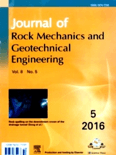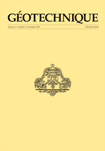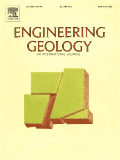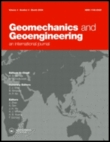
Geotechnik
Scope & Guideline
Pioneering Insights in Geotechnical Engineering and Geology
Introduction
Aims and Scopes
- Geotechnical Analysis and Design:
The journal emphasizes research on the analysis and design of geotechnical structures, including foundations, retaining walls, and earthworks, often using numerical methods and experimental studies. - Soil Behavior and Properties:
Research on the physical and mechanical properties of soils, including studies on soil classification, liquefaction, and the interaction of soils with structures, is a core focus area. - Sustainable Practices in Geotechnics:
The journal promotes the investigation of sustainable and environmentally friendly practices within geotechnical engineering, including the use of recycled materials and energy-efficient construction techniques. - Innovative Technologies and Methods:
'Geotechnik' showcases innovative technologies such as drone applications, digitalization in geotechnics, and advanced modeling techniques that enhance the efficiency and effectiveness of geotechnical practices. - Risk Assessment and Management:
The journal includes studies on risk assessment methodologies and management strategies for geotechnical projects, particularly under varying environmental conditions and uncertainties.
Trending and Emerging
- Digital Transformation in Geotechnics:
There is a noticeable increase in research related to digitalization, including the use of software tools, data analytics, and digital modeling techniques to improve geotechnical engineering practices. - Sustainable and Resilient Infrastructure:
Research focusing on sustainability, such as the use of geotextiles for levee resilience and CO2 footprint assessments, highlights a growing emphasis on creating environmentally friendly and resilient infrastructure. - Impact of Climate Change on Geotechnical Engineering:
Emerging studies are increasingly addressing the effects of climate change on soil behavior and geotechnical design, reflecting the urgent need to adapt engineering practices to changing environmental conditions. - Innovative Construction Techniques:
The journal is seeing a rise in publications discussing innovative construction methods, such as the use of mixed-in-place walls and modular construction, which enhance efficiency and sustainability. - Geotechnical Risk Management:
There is an increasing focus on risk assessment and management strategies in geotechnics, particularly in relation to natural disasters and the stability of structures under extreme conditions.
Declining or Waning
- Traditional Soil Testing Methods:
There seems to be a decline in papers focused on traditional soil testing methods, possibly due to the increasing adoption of advanced technologies and digital methods that provide more efficient and accurate results. - Generalized Applications of Soil Mechanics:
Research that broadly applies classic soil mechanics principles without specific innovations or adaptations has decreased, as the field moves towards more specialized and context-sensitive approaches. - Historical Analysis of Geotechnical Practices:
Papers focusing on historical perspectives or reviews of geotechnical practices are becoming less common, suggesting a shift towards forward-looking research that addresses current and future challenges in geotechnics.
Similar Journals

Geotechnical Engineering
Connecting Researchers and Practitioners in Geotechnical EngineeringGeotechnical Engineering, published by the Southeast Asian Geotechnical Society, is a prominent journal dedicated to the field of geotechnical and civil engineering. With its ISSN of 0046-5828, this journal serves as a vital platform for researchers and practitioners to disseminate innovative findings and explore new methodologies within the discipline. Although currently listed in the Q4 quartile across both Civil and Structural Engineering and Geotechnical Engineering categories, Geotechnical Engineering is committed to fostering rigorous scholarship and community engagement in the dynamic field of geotechnical sciences. The journal covers a wide range of topics, providing an important resource for the engineering community. While it does not offer open access, it facilitates significant contributions that enhance the understanding and practice of geotechnical engineering in Southeast Asia and beyond, underscoring its vital role as a knowledge hub for researchers, professionals, and students alike.

Indian Geotechnical Journal
Pioneering Research for Groundbreaking Solutions.Indian Geotechnical Journal, published by SPRINGER INDIA, is a premier publication dedicated to the cutting-edge field of geotechnical engineering and engineering geology. With an ISSN of 0971-9555 and an E-ISSN of 2277-3347, this journal serves as a pivotal platform for researchers, professionals, and students seeking to share innovative research and insights that contribute significantly to the development of the discipline. Recognized for its high-quality content, the journal holds a Q2 ranking in the Geotechnical Engineering and Engineering Geology category as of 2023, reflecting its influence and relevance in the academic community. Spanning contributions from 1972 to 1989 and resuming during 2012 to 2024, it showcases a historical depth coupled with contemporary research trends. Despite being a subscription-based journal, the quality of its articles ensures a broad readership, fostering collaboration and knowledge exchange among geotechnical professionals globally. Positioned at the intersection of theory and practice, the Indian Geotechnical Journal aims to advance understanding, encourage innovation, and address the pressing challenges faced in geotechnical engineering today.

Journal of Rock Mechanics and Geotechnical Engineering
Unlocking Solutions for Tomorrow’s Geotechnical ChallengesThe Journal of Rock Mechanics and Geotechnical Engineering is a premier open-access publication dedicated to advancing the field of geotechnical engineering and engineering geology. Published by SCIENCE PRESS and based in China, this journal has been a vital resource for researchers and professionals since it transitioned to open access in 2013. With ISSN 1674-7755 and E-ISSN 2589-0417, it has established a global reputation, evidenced by its impressive Q1 ranking in the category of Geotechnical Engineering and Engineering Geology as well as a remarkable 8th rank out of 229 in Earth and Planetary Sciences, placing it in the 96th percentile according to Scopus. The journal aims to publish high-quality research that addresses contemporary challenges in the field, offering insightful perspectives and innovative solutions. Researchers, professionals, and students are encouraged to engage with the latest findings and methodologies published within its pages, which span from 2013 to 2024 and continue to pave the way for future advancements in geotechnical practices.

Magazine of Civil Engineering
Empowering Engineers with Open Access ResearchMagazine of Civil Engineering, published by ST-PETERSBURG STATE POLYTECHNICAL UNIVERSITY, is a prominent open access journal dedicated to the field of civil and structural engineering. With an ISSN of 2712-8172 and E-ISSN 2071-0305, it serves as a vital platform for disseminating high-quality research, innovative methodologies, and current trends in building and construction. Since its inception in 2010, the journal has embraced open access, ensuring broad visibility and accessibility for its contributions to the academic community. The magazine holds a respectable position in the academic hierarchy, ranked in the Q3 quartile for both Building and Construction and Civil and Structural Engineering categories as of 2023. It is indexed in Scopus, amplifying its societal impact and reach with a rank of #114/223 in Building and Construction and #224/379 in Civil and Structural Engineering. Researchers, professionals, and students alike are encouraged to engage with the cutting-edge studies presented in the magazine, contributing to the advancement of knowledge and practice within the civil engineering domain.

Transportation Infrastructure Geotechnology
Pioneering Research in Infrastructure Sustainability and Safety.Transportation Infrastructure Geotechnology, an esteemed journal published by SpringerNature, serves as a vital platform in the fields of Civil and Structural Engineering, Environmental Engineering, Geotechnical Engineering, and Transportation. Established in 2014 and spanning a decade of significant scientific discourse, this journal has gained recognition for its robust contribution to the understanding of the interplay between geotechnical processes and transportation infrastructure. With an impactful Q2 ranking in multiple categories—including Civil and Structural Engineering and Environmental Engineering—it emphasizes innovative research and practical applications globally. Researchers and professionals can explore critical topics that influence infrastructure sustainability, safety, and efficiency. Although it operates under a subscription model, its affiliation with SpringerNature ensures rigorous peer-review and high-quality publications, making it an indispensable resource for academics and industry experts alike.

GEOTECHNIQUE
Advancing the Frontiers of Soil and Rock MechanicsGEOTECHNIQUE is a prestigious peer-reviewed journal published by Emerald Group Publishing Ltd, specializing in the fields of Geotechnical Engineering and Earth and Planetary Sciences. Established in 1948, this journal has consistently delivered groundbreaking research and advancements in the science of soil and rock mechanics, engineering geology, and environmental applications, aiming to foster innovation in geotechnical practices. With an impressive impact factor reflected in its Q1 ranking within both the Earth and Planetary Sciences and Geotechnical Engineering categories, GEOTECHNIQUE is recognized as a leading source of scholarly articles, positioning itself among the top 5% in the field. The journal is accessible via subscription, providing a repository of invaluable insights for researchers, professionals, and students striving to push the boundaries of knowledge and application in geotechnical topics. With a robust editorial board and a commitment to excellence, GEOTECHNIQUE continues to contribute significantly to the academic community and the practical engineering landscape.

ENGINEERING GEOLOGY
Pioneering Research for Sustainable InfrastructureENGINEERING GEOLOGY, published by Elsevier, is a leading journal in the fields of Geology and Geotechnical Engineering, recognized by its prestigious Q1 ranking in both categories for 2023. With a deep focus on the application of geological principles to engineering practices, this journal plays a vital role in advancing knowledge and methodologies that enhance infrastructure development and environmental sustainability. Operating since 1965, the journal disseminates high-quality research, offering insights that foster innovation in geotechnical assessments and geological hazard evaluation. Researchers and professionals benefit from its rigorous peer-review process and impactful studies, bolstered by a strong Scopus ranking - #4 in Geology and #3 in Geotechnical Engineering, both placing it in the top 2% of its field. Although there is no Open Access option available, the journal facilitates significant academic discourse, making it an essential resource for anyone involved in the intersection of geology and engineering.

International Journal of Physical Modelling in Geotechnics
Unveiling the complexities of soil and rock interactions.The International Journal of Physical Modelling in Geotechnics, published by Emerald Group Publishing Ltd, is a leading platform dedicated to advancing the field of geotechnical engineering and engineering geology. With a focus on the practical applications of physical modeling, this journal contributes significantly to the understanding of soil and rock behavior under various conditions, making it invaluable for researchers, professionals, and students alike. Heightened by its Q2 ranking in its category and a notable 61st percentile ranking among its peers, this journal has established itself as a credible source of knowledge and innovation within the academic community. Although it does not currently offer open access, its rigorous peer-review standards ensure the dissemination of high-quality research and insights. The journal, covering a timeline of topics from 2011 to 2024, aims to bridge the gap between theory and practice, ultimately fostering advancements in geotechnical solutions necessary for infrastructure development. To stay at the forefront of geotechnical research, contributing authors and engaged readers are encouraged to explore and participate in this dynamic academic discussion.

Geotechnique Letters
Fostering Excellence in Geotechnical Research.Geotechnique Letters is a prestigious journal published by Emerald Group Publishing Ltd, with a focused dedication to advancing the field of geotechnical engineering and engineering geology. Since its inception in 2011, the journal has rapidly established itself as a leading platform for disseminating high-quality research and innovative practices, earning a stellar Q1 ranking in both Earth and Planetary Sciences (miscellaneous) and Geotechnical Engineering categories as of 2023. With an ISSN of 2049-825X and E-ISSN 2045-2543, this journal captures vital insights and cutting-edge developments that cater to researchers, industry professionals, and students passionate about geotechnical challenges. Although it operates under a subscription model, the journal offers options for authors to publish their work—enhancing accessibility for those seeking to share knowledge within the community. The Scopus rankings place it comfortably within the top echelons of its field, affirming its importance and influence in shaping the future of geotechnical research and practice. With converged years extending to 2024, Geotechnique Letters is positioned as an essential resource for anyone looking to stay atop advancements and discussions in geotechnical sciences.

Geomechanics and Geoengineering-An International Journal
Exploring the Foundations of Earth and Engineering SciencesGeomechanics and Geoengineering-An International Journal, published by Taylor & Francis Ltd, serves as a prominent platform for the dissemination of innovative research and advancements in the fields of Geotechnical Engineering and Engineering Geology. With an ISSN of 1748-6025 and E-ISSN of 1748-6033, this journal has established itself as a critical resource within its category, ranking in the Q2 quartile according to the 2023 metrics and positioning itself in the top 38% of the Scopus rankings for Earth and Planetary Sciences. Geomechanics and Geoengineering encompasses a diverse range of topics, including but not limited to soil mechanics, foundation engineering, rock mechanics, and environmental geotechnics, ultimately aiming to advance both theoretical and practical knowledge in these vital areas. This journal not only highlights pioneering research but also facilitates a platform for academia and industry practitioners to collaborate and exchange ideas. While it does not offer open access, it remains a valuable resource for institutions and individuals committed to enhancing their expertise in the geotechnical domain. With convergence years spanning from 2006 to 2024, this journal is equipped to significantly contribute to the evolving landscape of geomechanical research.